List of extrasolar candidates for liquid water
This article needs to be updated. (January 2022) |

Extraterrestrial liquid water in the Solar System is likely uncommon, although it has been hypothesized to exist in some of its moons, and to have formerly existed on Mars and Venus.[2][3] Extrasolar liquid water has not yet been confirmed to exist. The following list contains candidates that meet the following criteria:
- Confirmed object of Earth mass or greater[a] orbiting within a circumstellar habitable zone (CHZ)
- May not be a star
- Has been studied for more than a year
- Confirmed surface with strong evidence for it being either solid or liquid
- Water vapour detected in its atmosphere
- Gravitational, radio or differentation models predict a wet stratum
Most known extrasolar planetary systems appear to have very different compositions from the Solar System, though there is sampling bias arising from the detection methods.
The goal of current searches is to find Earth-sized planets in the habitable zone of their planetary systems (also called the Goldilocks zone).[4] Planets with oceans could include Earth-sized moons of giant planets, though it remains speculative whether such 'moons' really exist. The Kepler telescope might be sensitive enough to detect them.[5] But there is evidence that rocky planets hosting water may be commonplace throughout the Milky Way.[6]
In June 2020, NASA scientists reported that it is likely that exoplanets with oceans may be common in the Milky Way galaxy, based on mathematical modeling studies.[7]
Planets
[edit]This section needs additional citations for verification. (November 2024) |
| Image | Planet | Star | Mass (× M⊕) |
Temp. (surf. mean, K) |
Distance (ly) |
Age (gy) |
Orbit (days) |
Discovery (year) |
Notes |
|---|---|---|---|---|---|---|---|---|---|
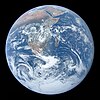
|
Earth | Sun | 1 | 288 | 0 | 4.54 | 365 | For comparison. | |

|
Harriot [citation needed] | Copernicus | ~47.5 | 200–300 | 41 | 7.4–8.7 | 260 | 2005 | * Gas giant likely has no surface, liquid water if present could only be on a large satellite (none known).[8] * Orbits within CHZ[9] * May be a Sudarsky Class II based on temperature observations[citation needed] |

|
Proxima Centauri b | Proxima Centauri | 1.27 | 234 | 4.37 | <4.6 | 11.186 | 2016 | * Orbits within the CHZ * Likely terrestrial. * Likely tidally locked to its star, if so, liquid water may be at terminator * 2000 times solar wind calculated, likely to break down any water, at least on the likely fixed star-facing side |

|
COROT-7b [citation needed] | COROT-7 | <9 | 1300–1800 | 489 | 1.2–2.3 | 0.85 | 2009 | * Not in the CHZ * Possibly terrestrial (unknown) * Most likely a tidally locked lava planet,[10] temperatures facing the star way too high. * Remote possibility of volatiles, but very likely have formed too close to star.[11] * Would need to possess cool night side with sufficient atmospheric pressure |
| COROT-9b [citation needed] | COROT-9 | 266.9 | 250–430 | 1500 | 95 | 2010 | * Not in the CHZ * Gas giant likely has no surface, liquid water if present could only be on a large satellite (none known) * density implies water in atmosphere, but none found yet * Possible class II ("water cloud") or class III ("clear") atmosphere planet[12] | ||

|
Gliese 581 c [citation needed] | Gliese 581 | 5.5 | 700–1000 | 20 | 7–11 | 12.9 | 2007 | * Not in the CHZ * Possibly not rocky * Water may be present as solid or vapour rather than liquid.[13] |

|
Gliese 667 Cc | Gliese 667 C | 3.7 | 277.4 | 23 | >2 | 28.1 | 2011 | * Orbits in middle of CHZ, but likely hotter than Earth * Likely terrestrial. * Tidal heating 300 times that of Earth may superheat the planet * Likely tidally locked, liquid water may be limited to terminator, or beyond with sufficient atmosphere |

|
Enaiposha | Orkaria | 7 | 393–555 | 42 | 6 | 1.58 | 2009 | * Not in the CHZ * Super-Earth sized * Composition unknown * Density models predict a wet core (unlikely to possess a surface) covered by thick atmosphere composed of volatiles similar to Neptune[14][15][16] |

|
HD 28185 b [citation needed] | HD 28185 | 1811.46 | 138 | 7.5 | 379.6 | 2001 | ||

|
HD 85512 b [citation needed] | HD 85512 | 3.6 | 298 | 36 | 5.6 | 54.43 | 2011 | |

|
MOA-2007-BLG-192Lb [citation needed] | MOA-2007-BLG-192L | 3.3 | 3000 | 2008 | ||||

|
Kepler-22b | Kepler-22 | <52.8 | 295 | 600 | ~4 | 289.8 | 2011 | * Orbits within the CHZ * Orbits sun-like star * Estimated temperature of 22 °C. * Composition is currently unknown.[17] |

|
Kepler-62e [citation needed] | Kepler-62 | 5 | ~270 | 1200 | 7 | 122.3 | 2013 | |

|
Kepler-62f [citation needed] | Kepler-62 | 1.413–2.80 | ~208 | 1200 | 3-11 | 267.2 | 2013 | |

|
Kepler-69c [citation needed] | Kepler 69 | ~6 | 548 | 2700 | 0.4 | 242.4 | 2013 | |
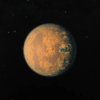
|
TRAPPIST-1d[18] | TRAPPIST-1 | 0.297 +0.035 −0.039 |
282.1 ± 4.0 K (8.95 ± 4.00 °C; 48.11 ± 7.20 °F) | 39 | 3–8 | 4.05 | 2016 | |
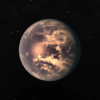
|
TRAPPIST-1e[18] | TRAPPIST-1 | 0.77 | 246 | 39 | 3–8 | 6.1 | 2017 | |

|
TRAPPIST-1f[18] | TRAPPIST-1 | 0.93 | 219 | 39 | 3–8 | 9.2 | 2017 | |

|
TRAPPIST-1g[18] | TRAPPIST-1 | 1.14 | 199 | 39 | 3–8 | 12.35 | 2017 |
Planetary systems
[edit]| Image | Star | Distance (ly) |
Age (gy) |
Discovery (year) |
Notes |
|---|---|---|---|---|---|
| AA Tauri | <1 | Protoplanetary disk has spectral signatures of water vapor. Solid bodies condensing from the disk should have liquid water, if they are the right distance from the star, have solid surfaces and atmospheres.[19] | |||
| Toliman | Star has some potential for a planet with liquid water if super dense planet with high gravity and atmospheric pressure is found orbiting it (none have to date).[20] | ||||
| GD 61 | White dwarf system that has first confirmed water-rich rocky planetary body (asteroid). No evidence of liquid water, but larger terrestrial planets, if found in the system, may be volatiles-rich.[21] | ||||
| TW Hydrae | Young star with protoplanetary disk containing detected clouds of water vapour cool enough to contain thousands of Earth-oceans' worth of water.[22] |
Description (alphabetical order)
[edit]Gliese 581 c, d and g
[edit]Later work suggests that Gliese 581 c would probably be too hot for liquid water. It was then suggested that Gliese 581 d might be warm enough for oceans if a greenhouse effect was operating.[23] Gliese 581 d is eight times the mass of the Earth and might have a thick atmosphere.
Gliese 581 d looks an even better candidate. The orbital period was originally estimated at 83 days and has now been revised to 66 days.[24] This was announced along with another new world, Gliese 581 e, which is next to twice the mass of Earth but too close to its sun for liquid water. In May 2011, a new study suggested that the planet might have a thick atmosphere, oceans and even life.[25]
The unconfirmed planet Gliese 581 g is another good candidate. This planet is estimated to be between three and four times as massive as the earth, and as such it is too small to be a gas giant. The orbital period is estimated at 37 days, which places its orbit right in the middle of the habitable zone of the star Gliese 581.[26]
Gliese 667 C - three planets
[edit]
Gliese 667 Cc was originally described as one of two 'super-Earth' planets around Gliese 667 C, a dim red star that is part of a triple star system. The stars of this system have a concentration of heavy elements only 25% that of our Sun's. Such elements are the building blocks of terrestrial planets so it was thought to be unusual for such star systems to have an abundance of low mass planets.[28] It seems that habitable planets can form in a greater variety of environments than previously believed.
Gliese 667 Cc, in a tight 28-day orbit of a dim red star, must receive 90% of the light that Earth receives, but most of its incoming light is in the infrared, so a higher percentage of this incoming energy should be absorbed by the planet. The planet is expected to absorb about the same amount of energy from its star that Earth absorbs from the Sun, which would allow surface temperatures similar to Earth and perhaps liquid water.[29]
Further work published in June 2013 suggests that the system has six planets, and that three of them are in the habitable zone.[30]
HD 28185 b
[edit]HD 28185 b was the first exoplanet to be detected in the habitable zone.[31] The planet has only been detected indirectly, but is believed to be a gas giant, with no solid surface. Some scientists have argued that it could have moons large and stable enough to have oceans and probably life.[32]
HD 85512 b
[edit]HD 85512 b was discovered in August 2011. It is larger than Earth, but small enough to be probably a rocky world. It is on the borders of its star's habitable zone and might have liquid water, and is a potential candidate for a life-supporting world.[33][34]
MOA-2007-BLG-192Lb
[edit]MOA-2007-BLG-192Lb is a small planet orbiting a small star. It is about 3 Earth masses, currently the second smallest detected extrasolar planet orbiting a normal star, after Gliese 581 e.
The planet orbits its host star or brown dwarf with an orbital radius similar to that of Venus. But the host is likely to be between 3,000 and 1 million times fainter than the Sun, so the top of the planet's atmosphere is likely to be colder than Pluto. However, the planet is likely to maintain a massive atmosphere that would allow warmer temperatures at lower altitudes. It is even possible that interior heating by radioactive decay would be sufficient to make the surface as warm as the Earth, but theory suggests that the surface may be completely covered by a very deep ocean.[35] life here will have to look for analogues of photosynthesis.
Kapteyn b
[edit]Kapteyn b is a super-Earth orbiting within the habitable zone of Kapteyn's Star, which is 13 light-years away and is 11 billion years old.[36]
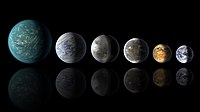
However, evidence in 2021 ruled out the existence of this planet.[38]
Kepler-62e and Kepler-62f
[edit]The star Kepler-62 has five planets, two of which are the right distance from the star to have liquid water and potentially sustain life.[39]
Kepler-62f is only 40 percent larger than Earth, making it the exoplanet closest to the size of Earth known in the habitable zone of another star. Kepler-62e orbits on the inner edge of the habitable zone and is roughly 60 percent larger than Earth.[40] Both are assumed to be rocky planets, but since the star is 1200 light-years away, it's hard to be sure.
Kepler-69c
[edit]This large rocky planet is one of two known to be orbiting the star Kepler 69, which is similar to the Sun. It's believed to be in the star's habitable zone.
It's 70% more massive than the Earth and has a 242-day orbit, similar to that of Venus.
NASA announced its discovery on 18 April 2013, along with the two Earth-like planets of Kepler 62.[40]
Kepler (other results)
[edit]Among the 1,235 possible extrasolar planet candidates detected by NASA's planet-hunting Kepler space telescope during its first four months of operation, 54 are orbiting in the parent star's habitable 'Goldilocks' zone where liquid water could exist.[41] Five of these are near Earth-size, and the remaining 49 habitable zone candidates range from twice the size of Earth to larger than Jupiter.[42]
Proxima b
[edit]Proxima Centauri b, the nearest known exoplanet, is in the habitable zone of its host star, and might contain liquid water.[43]
[44] More details about the planet's physical conditions are needed for a proper evaluation of its habitability.[45][46][47]
TOI-1452 b
[edit]In August 2022, water was detected on the exoplanet TOI-1452 b based on studies with data from the Transiting Exoplanet Survey Satellite (TESS).[48][49]
TRAPPIST-1 - four planets
[edit]In February 2017, seven planets were discovered in the star system TRAPPIST-1, previously unknown to host any planets. Four of the discovered planets, called TRAPPIST-1d, TRAPPIST-1e, TRAPPIST-1f and TRAPPIST-1g, are candidates for liquid water. They are all located towards the outer system (with the closest to the star, TRAPPIST-1d, being within or slightly outside the inner edge of the habitable zone), making them cool planets. TRAPPIST-1e and f are probably tidally locked planets, and if liquid water exists in them, it is located in their respective terminator lines. However, if the planets support a thick enough atmosphere to transfer heat to the sides facing away from the star, much larger portions of them may be habitable.
WASP-96b
[edit]In July 2022, water was detected on the exoplanet WASP-96b based on spectrum studies with the James Webb Space Telescope.[50]
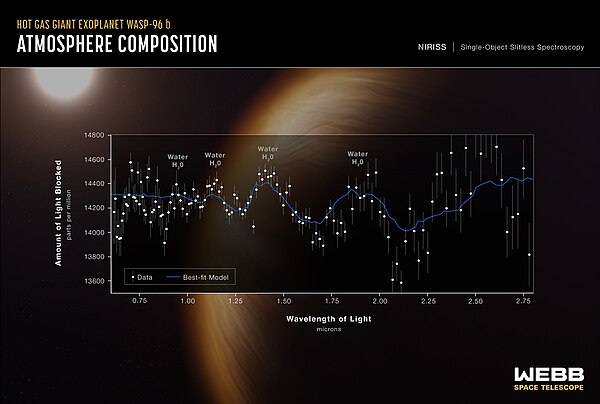
See also
[edit]Notes
[edit]- ^ Less massive objects' gravity may be too weak to retain water
References
[edit]- ^ "Hubble traces faint signatures of water in exoplanet atmospheres (artist's illustration)". ESA/Hubble Press Release. Retrieved 5 December 2013.
- ^ "Mars Probably Once Had A Huge Ocean". Sciencedaily.com. 2007-06-13. Retrieved 2012-01-22.
- ^ Owen, (2007), news.nationalgeographic.com/news/2007/11/071128-venus-earth_2.html Archived 2016-05-11 at the Wayback Machine
- ^ "Habitable planets may be common". Newscientist.com. Retrieved 2012-01-22.
- ^ "The hunt for habitable exomoons". Astronomynow.com. 2009-09-04. Retrieved 2012-01-22.
- ^ "Water, water everywhere". Astronomynow.com. Retrieved 2012-01-22.
- ^ Shekhtman, Lonnie; et al. (18 June 2020). "Are Planets with Oceans Common in the Galaxy? It's Likely, NASA Scientists Find". NASA. Retrieved 20 June 2020.
- ^ Bowdler, Neil (2007-11-07). "Astronomers discover new planet". BBC News. Retrieved 2012-01-22.
- ^ Ian Sample, science correspondent (7 November 2007). "Could this be Earth's near twin? Introducing planet 55 Cancri f". The Guardian. London. Archived from the original on 2 October 2008. Retrieved 17 October 2008.
{{cite news}}:|author=has generic name (help) - ^ Ker Than (October 6, 2009). "Hellish Exoplanet Rains Hot Pebbles, Has Lava Oceans". National Geographic. Archived from the original on October 10, 2009.
- ^ Schaefer, L.; Fegley, B. (2009). "Chemistry of Silicate Atmospheres of Evaporating Super-Earths". Astrophysical Journal Letters. 703 (2): L113 – L117. arXiv:0906.1204. Bibcode:2009ApJ...703L.113S. doi:10.1088/0004-637X/703/2/L113. S2CID 28361321.
- ^ "Sizing up a temperate exoplanet". Astronomynow.com. 2010-03-17. Retrieved 2012-01-22.
- ^ "New Planet Could Harbor Water and Life". Space.com. 2007-04-24. Retrieved 2012-01-22.
- ^ Rogers, L.A.; Seager, S. (2010). "Three Possible Origins for the Gas Layer on GJ 1214b". The Astrophysical Journal (abstract). 716 (2): 1208–1216. arXiv:0912.3243. Bibcode:2010ApJ...716.1208R. doi:10.1088/0004-637X/716/2/1208. S2CID 15288792.
- ^ "Distant 'waterworld' is confirmed". BBC News. 21 February 2012. Archived from the original on 2018-12-27. Retrieved 2018-06-20.
- ^ "Hubble Reveals a New Class of Extrasolar Planet". Archived from the original on 2017-09-04. Retrieved 2018-02-28.
- ^ "Kepler 22-b: Earth-like planet confirmed". BBC News. 2011-12-05. Retrieved 2012-01-22.
- ^ a b c d Pultarova, Tezera (11 August 2023). "Exoplanets in the Trappist-1 system more likely to be habitable than scientists once thought, study suggests". space.com. Future US Inc. Retrieved 4 May 2024.
- ^ "Organics and water found where new planets may grow". Spaceflightnow.com. Retrieved 2012-01-22.
- ^ "Star next door may host a 'superhabitable' world". New Scientist.
- ^ "Water Discovered in Remnants of Extrasolar Rocky World Orbiting White Dwarf". Archived from the original on 2017-09-02. Retrieved 2018-02-28.
- ^ Hogerheijde, M. R.; Bergin, E. A.; Brinch, C.; Cleeves, L. I.; Fogel, J. K. J.; Blake, G. A.; Dominik, C.; Lis, D. C.; Melnick, G.; Neufeld, D.; Panic, O.; Pearson, J. C.; Kristensen, L.; Yildiz, U. A.; Van Dishoeck, E. F. (2011-10-20). "Nearby Planet-Forming Disk Holds Water for Thousands of Oceans". Science. 334 (6054): 338–340. arXiv:1110.4600. Bibcode:2011Sci...334..338H. doi:10.1126/science.1208931. PMID 22021851. S2CID 206535551. Retrieved 2012-01-22.
- ^ "Scientists might have picked right star, wrong world for hosting life". NBC News. 2007-06-18. Retrieved 2012-01-22.
- ^ "Sibling worlds may be wettest and lightest known". Newscientist.com. Retrieved 2012-01-22.
- ^ "Exoplanet near Gliese 581 star 'could host life'". BBC News. 2011-05-17. Retrieved 2012-01-22.
- ^ "NASA and NSF-Funded Research Finds First Potentially Habitable Exoplanet". Release 10-237. NASA. 2010-09-29.
- ^ "Many Billions of Rocky Planets in the Habitable Zones around Red Dwarfs in the Milky Way". ESO Press Release. Retrieved 29 March 2012.
- ^ "New Super-Earth Detected Within the Habitable Zone of a Nearby Cool Star". Archived from the original on 2019-12-30. Retrieved 2018-02-28.
- ^ "Super-Earth orbits in habitable zone of cool star". Archived from the original on 2016-03-11. Retrieved 2014-03-24.
- ^ "Three Planets in Habitable Zone of Nearby Star: Gliese 667c Reexamined". Archived from the original on 2018-01-07. Retrieved 2018-02-28.
- ^ Jones, B. W.; Sleep, P. N.; Underwood, D. R. (2006). "Habitability of Known Exoplanetary Systems Based on Measured Stellar Properties". The Astrophysical Journal. 649 (2): 1010–1019. arXiv:astro-ph/0603200. Bibcode:2006ApJ...649.1010J. doi:10.1086/506557. S2CID 119078585.
- ^ Barnes, J. W.; O’Brien, D. P. (2002). "Stability of Satellites around Close-in Extrasolar Giant Planets". The Astrophysical Journal. 575 (2): 1087–1093. arXiv:astro-ph/0205035. Bibcode:2002ApJ...575.1087B. doi:10.1086/341477. S2CID 14508244.
- ^ "Exoplanet Looks Potentially Lively". Scientificamerican.com. Retrieved 2012-01-22.
- ^ "'Super-Earth,' 1 of 50 Newfound Alien Planets, Could Potentially Support Life". News.yahoo.com. 2011-09-12. Retrieved 2012-01-22.
- ^ "Small Planet Discovered Orbiting Small Star". Sciencedaily.com. 2008-06-02. Retrieved 2012-01-22.
- ^ "Astronomers discover two new worlds orbiting ancient star next door: One may be warm enough to have liquid water". Retrieved 3 October 2015.
- ^ "Water-worlds are common: Exoplanets may contain vast amounts of water". Phys.org. 17 August 2018. Retrieved 17 August 2018.
- ^ Bortle, Anna; Fausey, Hallie; Ji, Jinbiao; Dodson-Robinson, Sarah; Ramirez Delgado, Victor; Gizis, John (2021), "A Gaussian Process Regression Reveals No Evidence for Planets Orbiting Kapteyn's Star", The Astronomical Journal, 161 (5): 230, arXiv:2103.02709, Bibcode:2021AJ....161..230B, doi:10.3847/1538-3881/abec89
- ^ "Kepler telescope spies 'most Earth-like' worlds to date". BBC News. 18 April 2013. Archived from the original on 2018-04-21. Retrieved 2018-06-20.
- ^ a b "NASA's Kepler Discovers Its Smallest 'Habitable Zone' Planets to Date". Archived from the original on 2020-05-08. Retrieved 2014-03-24.
- ^ "Kepler detects more than 1,200 possible planets". Spaceflightnow.com. Retrieved 2012-01-22.
- ^ Lissauer, Jack J.; Fabrycky, Daniel C.; Ford, Eric B.; Borucki, William J.; Fressin, Francois; Marcy, Geoffrey W.; Orosz, Jerome A.; Rowe, Jason F.; Torres, Guillermo; Welsh, William F.; Batalha, Natalie M.; Bryson, Stephen T.; Buchhave, Lars A.; Caldwell, Douglas A.; Carter, Joshua A.; Charbonneau, David; Christiansen, Jessie L.; Cochran, William D.; Desert, Jean-Michel; Dunham, Edward W.; Fanelli, Michael N.; Fortney, Jonathan J.; Gautier Iii, Thomas N.; Geary, John C.; Gilliland, Ronald L.; Haas, Michael R.; Hall, Jennifer R.; Holman, Matthew J.; Koch, David G.; et al. (2011-02-02). "NASA Finds Earth-Size Planet Candidates in Habitable Zone, Six Planet System". Nature. 470 (7332). Sciencedaily.com: 53–58. arXiv:1102.0291. Bibcode:2011Natur.470...53L. doi:10.1038/nature09760. PMID 21293371. S2CID 4388001. Retrieved 2012-01-22.
- ^ Anglada-Escudé, Guillem; Amado, Pedro J.; Barnes, John; et al. (2016). "A terrestrial planet candidate in a temperate orbit around Proxima Centauri" (PDF). Nature. 536 (7617): 437–440. arXiv:1609.03449. Bibcode:2016Natur.536..437A. doi:10.1038/nature19106. PMID 27558064. S2CID 4451513.
- ^ Witze, Alexandra (24 August 2016). "Earth-sized planet around nearby star is astronomy dream come true". Nature. 536 (7617): 381–382. Bibcode:2016Natur.536..381W. doi:10.1038/nature.2016.20445. PMID 27558041. S2CID 4405961.
- ^ Clery, Daniel (26 August 2016). "The exoplanet next door". Science News. Vol. 353, no. 6302. p. 857. doi:10.1126/science.353.6302.857. Retrieved 28 August 2016.
Researchers have already found hundreds of similarly sized planets, and many appear to be far better candidates for hosting life than the one around Proxima Centauri, called Proxima b.
- ^ Amos, Jonathan (24 August 2016). "Neighbouring star Proxima Centauri has Earth-sized planet". BBC News. Retrieved 25 August 2016.
Just how "habitable" this particular planet really is, one has to say is pure speculation for the time being.
- ^ Ribas, Ignasi; Bolmont, Emeline; Selsis, Franck; et al. (25 August 2016). "The habitability of Proxima Centauri b: I. Irradiation, rotation and volatile inventory from formation to the present". Astronomy & Astrophysics. 596: A111. arXiv:1608.06813. Bibcode:2016A&A...596A.111R. doi:10.1051/0004-6361/201629576. S2CID 119253891.
- ^ DePresse, Salle (24 August 2022). "An extrasolar world covered in water?". Université de Montréal. Retrieved 19 September 2022.
- ^ Brennan, Pat (24 August 2022). "Discovery Alert: Intriguing New 'Super-Earth' Could Get a Closer Look". NASA. Retrieved 19 September 2022.
- ^ a b Cesari, Thaddeus (11 July 2022). "NASA Shares List of Cosmic Targets for Webb Telescope's First Images". NASA. Archived from the original on 12 July 2022. Retrieved 19 September 2022.

